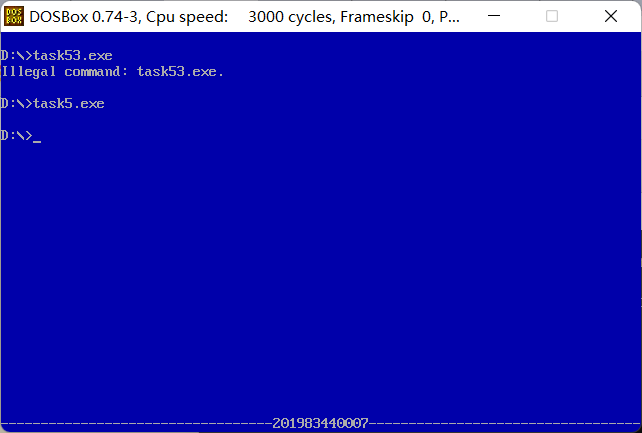1. Experimental task 1
The program task1.asm source code is given
assume cs:code, ds:data data segment x db 1, 9, 3 len1 equ $ - x y dw 1, 9, 3 len2 equ $ - y data ends code segment start: mov ax, data mov ds, ax mov si, offset x mov cx, len1 mov ah, 2 s1:mov dl, [si] or dl, 30h int 21h mov dl, ' ' int 21h inc si loop s1 mov ah, 2 mov dl, 0ah int 21h mov si, offset y mov cx, len2/2 mov ah, 2 s2:mov dx, [si] or dl, 30h int 21h mov dl, ' ' int 21h add si, 2 loop s2 mov ah, 4ch int 21h code ends end start

Answer question ① line27. When the assembly instruction loop s1 jumps, it jumps according to the displacement. Check the machine code through debug disassembly and analyze the jump displacement? (the displacement value is answered in decimal) from the perspective of the CPU, explain how to calculate the offset address of the instruction after the jump label s1.
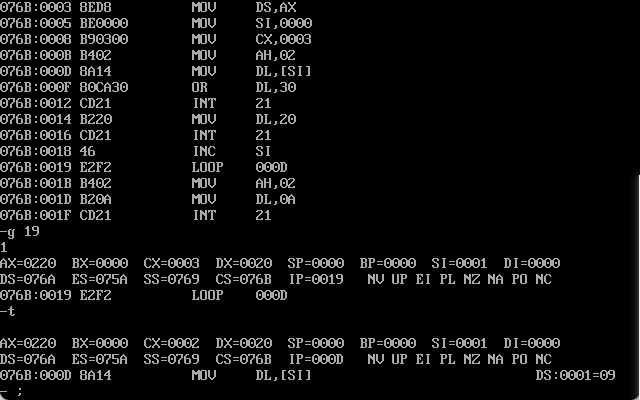
The IP jumps from 001B to 000D with an offset of - 14
Answer question ② line44. When the assembly instruction loop s2 jumps, it jumps according to the displacement. Check the machine code through debug disassembly and analyze the jump displacement? (the displacement value is answered in decimal) from the perspective of the CPU, explain how to calculate the offset address of the instruction after the jump label s2.
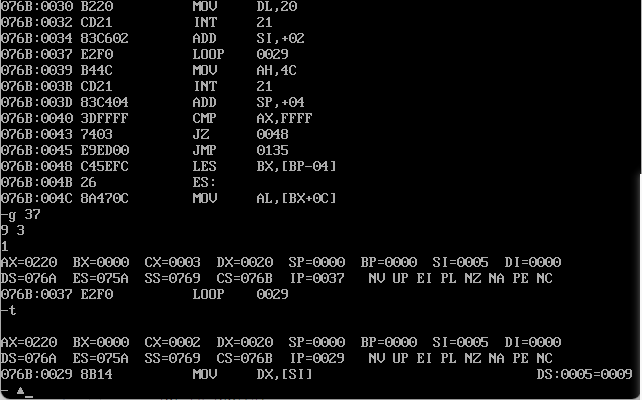
The IP jumps from 0039 to 0029 with an offset of - 16
2. Experimental task 2
The program task2.asm source code is given
assume cs:code, ds:data data segment dw 200h, 0h, 230h, 0h data ends stack segment db 16 dup(0) stack ends code segment start: mov ax, data mov ds, ax mov word ptr ds:[0], offset s1 mov word ptr ds:[2], offset s2 mov ds:[4], cs mov ax, stack mov ss, ax mov sp, 16 call word ptr ds:[0] s1: pop ax call dword ptr ds:[2] s2: pop bx pop cx mov ah, 4ch int 21h code ends end start
① According to the jump principle of call instruction, it is analyzed theoretically that before the program executes to exit (line31), register (ax) =? Register (bx) =? Register (cx) =?
From line 16 to 18 of the program, we can see that the offset address of s1 is stored in ds:[0], the offset address of s2 is stored in ds:[1], and the segment address of data segment is stored in ds:[4]. In line 24, because the offset address is pushed into the stack by executing the call instruction, ds:[0] The word data stored in is the offset address of s1, so the offset address of s1 is stored in ax. In line 27, the double word data of ds:[2], that is, ds:[2] and ds:[4], so the offset address of s2 is stored in bx and the segment address of data segment is stored in cx.
That is, ax = ip of S1, BX = ip of S2, CX = cs of S2
② Assemble and link the source program to get the executable program task2.exe. Use debug to observe and verify whether the debugging results are consistent with the theoretical analysis results.
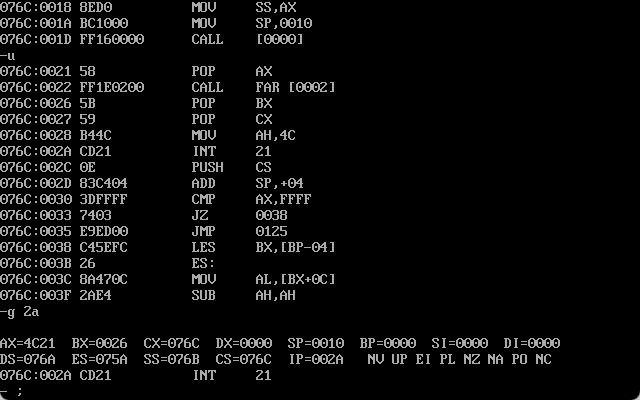
It can be found that ax = 4c21, bx = 0026, cx = 076c
3. Experimental task 3
This part of the experiment is mainly to separate the two digits into ten bits and one bit, then convert the two parts into ASCII code, and then use the No. 2 subroutine of int21h to output it
The program source code task3.asm is given
1 assume cs:code, ds:data 2 3 data segment 4 x db 99, 72, 85, 63, 89, 97, 55 5 len equ $- x 6 data ends 7 8 code segment 9 start: 10 mov ax, data 11 mov ds, ax; 12 mov si, 0 13 mov cx, len ;Data is byte,len Is the data length 14 s: 15 mov ah, 0 ;The number has only one byte, so ah=0 16 mov al, [si] 17 mov bx, offset printNumber 18 call bx 19 mov bx, offset printSpace 20 call bx 21 inc si 22 loop s 23 mov ah, 4ch 24 int 21h 25 26 printNumber: 27 mov bl, 10 28 div bl;Separate ten bits and one bit 29 mov bx, ax 30 31 mov dl, bl ;Quotient 32 add dl, 30h ;convert to ascii 33 mov ah, 2 ;call int 21h Subroutine 2 of 34 int 21h; 35 36 mov dl, bh ;Remainder 37 add dl, 30h ;convert to ascii 38 mov ah, 2 ;call int 21h Subroutine 2 of 39 int 21h; 40 ret 41 42 printSpace: 43 mov dl, ' ' 44 mov ah, 2 45 int 21h 46 ret 47 48 code ends 49 end start
Screenshot of running test

4. Experimental task 4
The program source code task4.asm is given
1 assume ds:data, cs:code 2 data segment 3 str db 'try' 4 len equ $ - str 5 data ends 6 7 code segment 8 start: 9 mov ax, data 10 mov ds, ax 11 mov ax, 0b800h 12 mov es, ax 13 mov si, 0 14 mov dh, 0 ;Line number 15 mov bl, 2 ;colour 16 call printStr 17 18 mov si, 0 19 mov dh, 24 ;Line number 20 mov bl, 4 ;colour 21 call printStr 22 mov ax, 4c00h 23 int 21h 24 25 printStr: 26 mov al, 160 ;One line can store 80 characters and 160 bytes 27 mul dh 28 mov dx, ax ;Relative addressing can only be used bx, bp, si, di 29 mov al, bl 30 mov bx, dx 31 mov cx, len 32 s: 33 mov dl, [si] 34 mov es:[bx], dl 35 inc bx 36 mov es:[bx], al 37 inc bx 38 inc si 39 loop s 40 ret 41 code ends 42 end start
Screenshot of running test
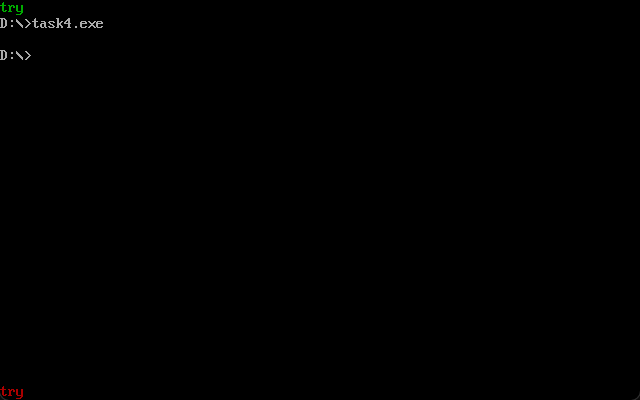
5. Experimental task 5
The program source code task5.asm is given
1 assume cs:code, ds:data 2 data segment 3 stu_no db '201983440007' 4 len = $ - stu_no 5 data ends 6 7 code segment 8 start: 9 mov ax, data 10 mov ds, ax 11 mov ax, 0b800h 12 mov es, ax 13 ;Tone background color 14 mov si, 1 15 mov dl, 17h ; 0 001 0 111 16 mov cx, 2000 17 blue: 18 mov es:[si], dl 19 add si, 2 20 loop blue 21 ;Print horizontal lines 22 mov dh, 24 23 mov al ,160 24 mul dh ;Calculation start position 25 mov bx, ax 26 call line 27 28 mov cx, len 29 mov si, 0 30 sn: 31 mov dl, ds:[si] 32 mov es:[bx], dl 33 inc si 34 add bx, 2 35 loop sn 36 37 call line 38 mov ax, 4c00h 39 int 21h 40 41 line: 42 mov dl, '-' 43 mov cx, 34 ;( 80- 12 ) / 2 44 s: 45 mov es:[bx], dl 46 add bx, 2 47 loop s 48 ret 49 code ends 50 end start
Screenshot of running test
